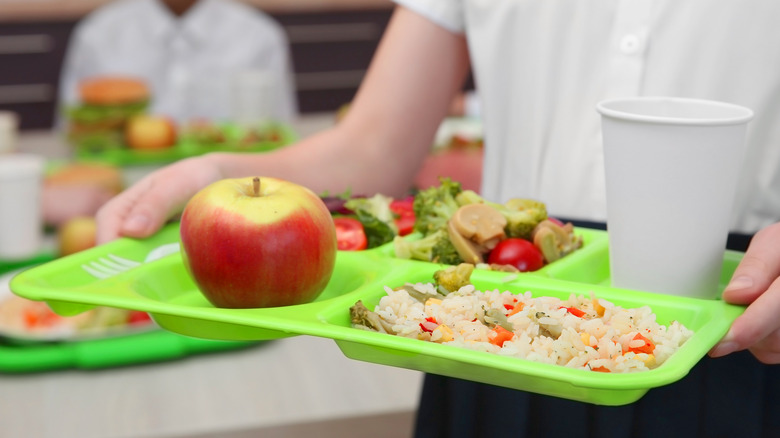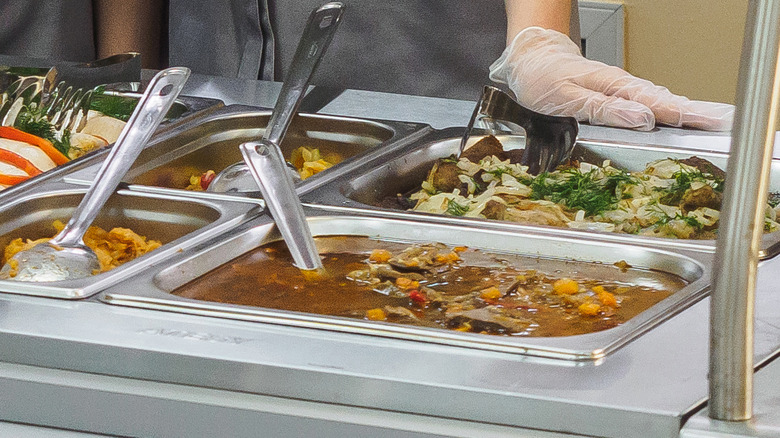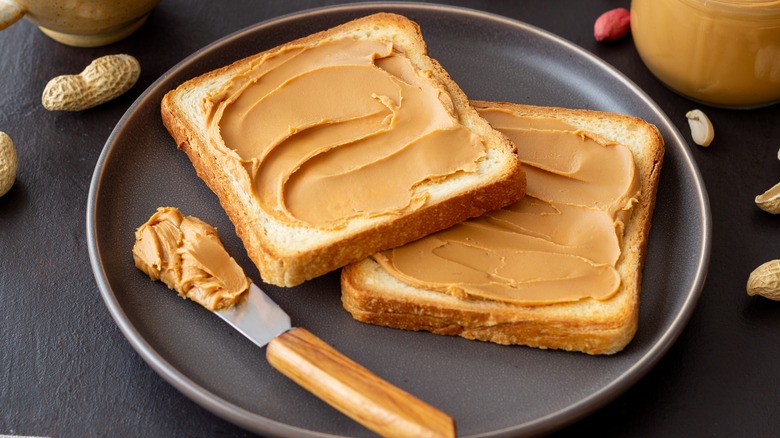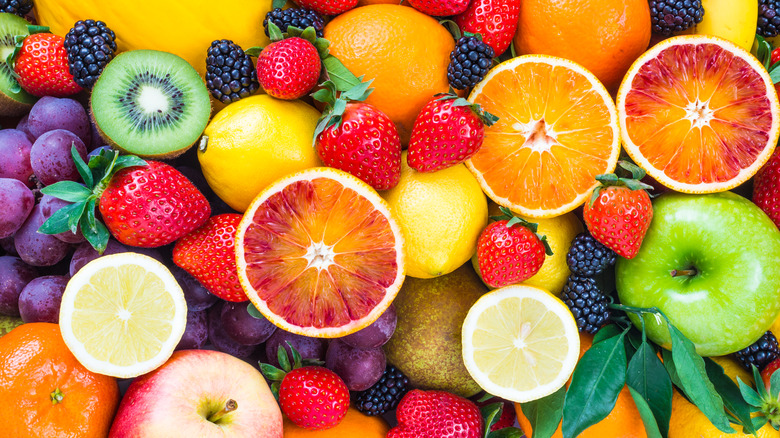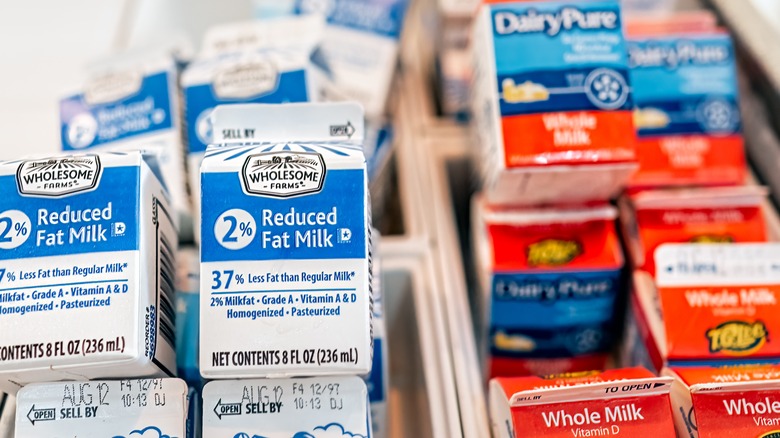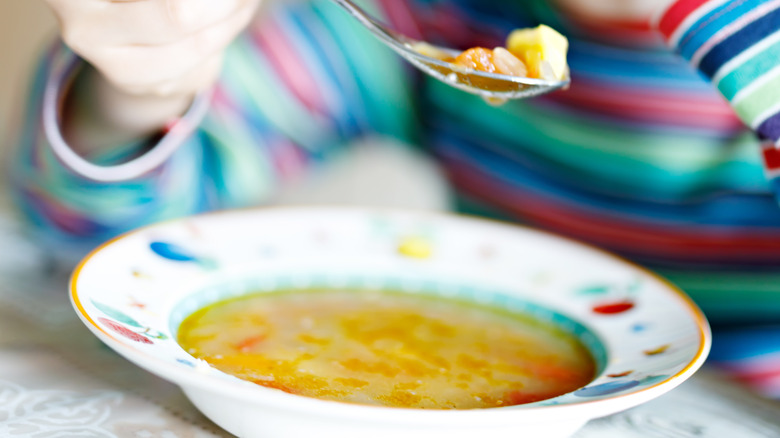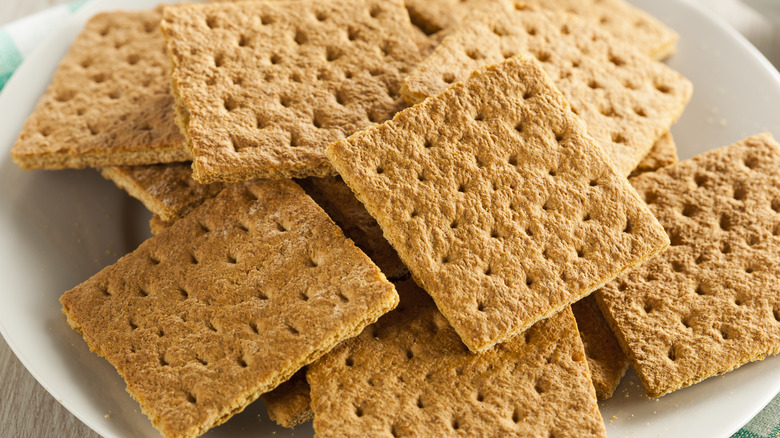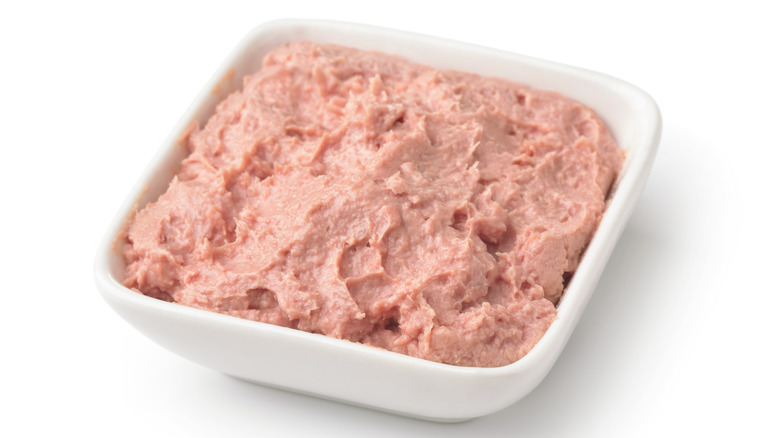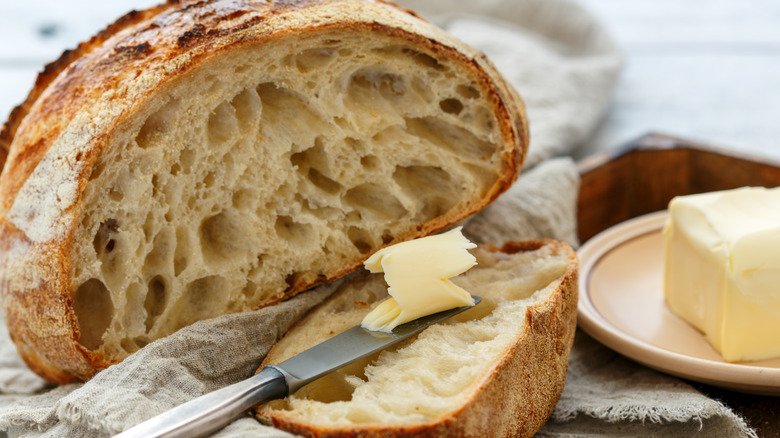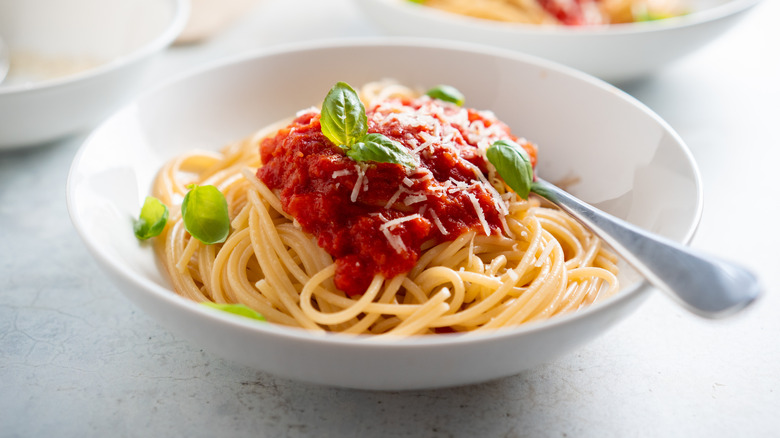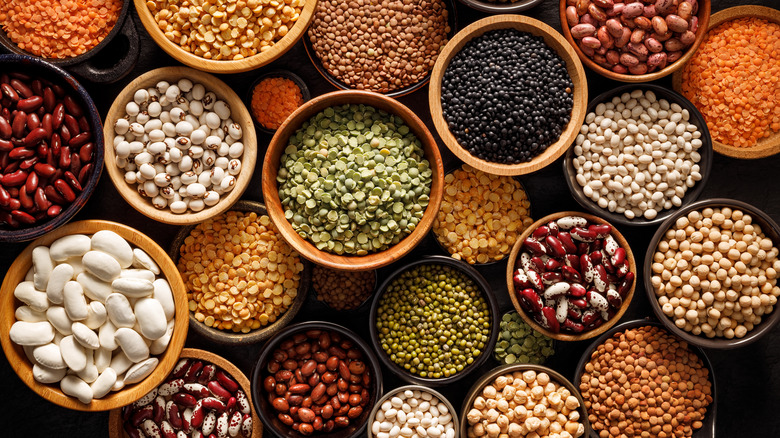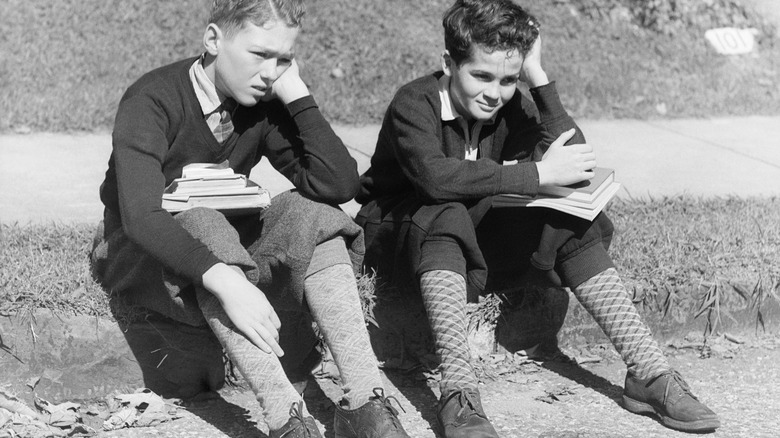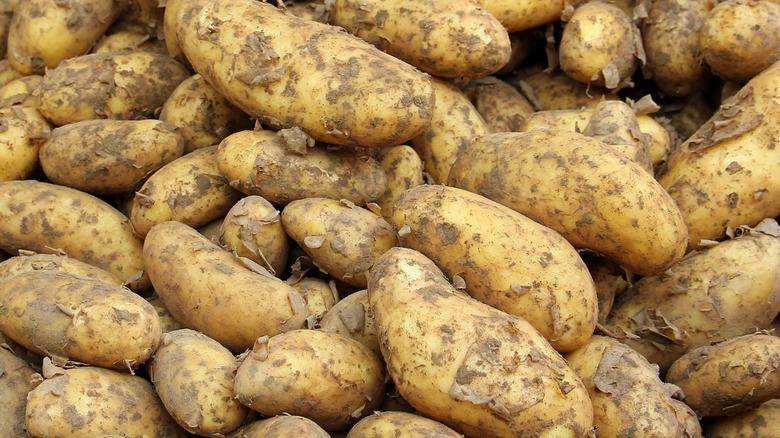What School Lunches Looked Like During The Great Depression
When Minnesota state senator Steve Drazkowski argued against a free school lunch program in February 2023, declaring he'd never met "a person in (the state) that says they don't have access to enough food," we were perplexed. Not only did this utterly ridiculous statement imply he'd spoken with all 5.7 million residents living in Minnesota, but the GOP state senator's eagerness to restrict access to non-cost prohibitive (and healthy) school lunches in the Land of 10,000 Lakes came off downright ghoulish.
Perhaps Drazkowski was simply born in the wrong century. After all, if he'd been alive before former president Franklin Delano Roosevelt instituted a national school lunch program as part of the New Deal during the Great Depression, most U.S. citizens might be apt to agree with his position on the matter (mainly because nationwide school lunch programs didn't yet exist).
Now, while we know precisely what modern school lunches look like, we had little to no idea what students were served when those programs began in the 1930s. But given our categorical curiosity about school lunch specifics during that economically-tumultuous time, we decided to investigate. So if you're looking to scratch a historical itch, keep reading as we reveal what school lunches looked like during the Great Depression.
Hot meals (as often as possible)
Despite being the world's richest country in 2021, more than five million U.S. children lived in food insecure houses that year. Frankly, that shameful statistic is astounding, but it's not exactly a surprise. After all, this nation's history is riddled with examples of underfed and malnourished children, including during the Great Depression. Thankfully, administrators at that time recognized many students were unlikely to eat much before or after lunch, so to help fill any nutritional gaps, hearty, filling meals became essential – with a particular focus on hot dishes.
"Growing children need a hot mid-day meal," Works Progress Administration (WPA) assistant administrator Ellen S. Woodward wrote in 1937 (via Virginia Commonwealth University). Consequently, hot lunches were prioritized in the 30-plus states that participated in the school lunch program during the Depression — a move that often led to a host of stunningly positive improvements for students.
Since the human body does, in fact, tend to take longer to digest hot, freshly-prepared foods, it's no wonder the WPA focused on hot dishes (or why that category of food remains prevalent in modern school cafeterias). And with the school lunch program having served more than 80-million hot meals in participating schools by October 1937, with an estimated one million students having benefited? That plan came to fruition.
Peanut butter sandwiches
If you (like Everclear) have ever had the so-called joy of a welfare Christmas, you almost certainly understand the appeal of peanut butter sandwiches. Peanut butter is a nutritional dynamo in more ways than one, after all, as well as a consistently cheap food item that fits into any budget. With that in mind, it can't be shocking to discover peanut butter sandwiches were a common school lunch staple during the Great Depression.
Now, while serving hot dishes was clearly preferred by the WPA, ensuring students had an adequate selection of foods to consume was just as crucial — so long as those options were both cost-effective and easy to prepare. Since peanut butter sandwiches are almost comically simple to make (and made with two lower-cost products), it's obvious why the food was a familiar presence at school lunches throughout the 1930s.
Interestingly enough, school lunch programs weren't always satisfied with simply peanut butter and bread, so additional ingredients may have been featured. In fact, as recommended by the 1936 USDA-issued book "Menus and Recipes for Lunches at School," the sandwich's filling could be enhanced by using "peanut butter mixed with mild salad dressing."
Raw fruit
Imagining a person who's unaware of the importance of fruits and vegetables in 2023, or oblivious to the mountain of benefits found from eating produce, is utterly inconceivable. Frankly, we'd venture to guess this fact was widely known even a century ago in 1923 (the year, not the series). If nothing else, though, the need to eat fruits and vegetables appears to have been accepted by the 1930s, hence school lunch programs' tendency to serve students a variety of raw fruits during the Great Depression.
The choice to prioritize raw, uncooked fruit for school lunches wasn't by chance, since school lunch program developers understood children are inherently attracted to the sweetness of raw fruit (or any sweet food, really). More than that, the focus on raw (rather than cooked) fruit seemed driven by a desire to provide students with the maximum amount of vitamins and minerals; and since cooking certain fruits can cause a reduction in that food's nutrient levels, raw fruit was the preference.
Of course, schools weren't banned from serving fruit that had been previously cooked by any means, which makes sense. After all, eating anything is generally better than nothing for the human body — particularly when it comes to fruits and veggies.
Milk
In a society where obesity runs wild, identifying the underlying causes of the problem can be tricky. But culprits clearly exist, and many beverages — like the near-infinite number of high-calorie, sugar-and-fat-bombs on the market — deserve a dishonorable mention. Of course, the flip side of this is that healthy, nourishing drinks are available to consumers, as well, including the school cafeteria staple (stretching back to the Great Depression) that's known to do a body good: milk.
Now, the benefits of drinking milk — and that would be cow's milk, AKA milk classic — have been universally-known for what feels like time eternal, so it's hardly a mystery why school lunch administrators of the 1930s widely prioritized its availability. But the fact that "many of the children ... come from homes where milk is a luxury," as WPA assistant administrator Ellen S. Woodward wrote in 1937 (via Virginia Commonwealth University), meant the need to provide milk with school lunches was doubly important during that time.
Perhaps dairy-based milk appears less-than-essential in a culture where a virtually-limitless number of healthy drinks are always available. But when pickings are slim, as they tended to be during that national financial crisis, the potent combination of nutrients in milk (including, but not limited to, protein, calcium, potassium, and vitamin D) makes it perfect for school lunch inclusion.
Vegetable soups
There's a number of tried-and-true culinary techniques that help stretch a food item to its literal limit. These cooking preparations are exceptionally handy when you're aiming to both minimize food waste, and feed as many mouths as possible — two essential goals for school lunches during the Great Depression. Since one of the best ways to doing this involves making a soup, it's clear why soups (and a number of vegetable soups, in particular) were a common menu option at that time.
Whether it was a hearty soup starring a vegetable of some sort (like a split-pea soup with cured pork), or a genuinely (and generically) labeled vegetable soup product (featuring onions, celery, corn, and peas), school cafeterias were chock full of veggie-based soup options. Did children at the time become sick and tired of the many vegetable soups found at their schools? We can't say for sure — but knowing the nature of children, it's more than likely.
In that sense, perhaps vegetable soups weren't the top meal choice for the average U.S. child in the 1930s. But the importance of vegetables can't be overstated, and since a child's health was the number one factor in menu preparation, vegetable soups were a common sight at school lunches.
Graham crackers
Kids love to snack on sweets. Sure, there's the occasional out-of-the-ordinary child who prefers a baby carrot to a strawberry (or, say, a Dunkaroo). But, by and large, kids can't get enough of those sugar-saturated products that are all but guaranteed to rot their smiling teeth. Of course, even a less cloyingly sweet snack is appealing to young palates, especially when those foods don't break the bank. Consequently, it's no surprise graham crackers were a common snack with school lunches from the Great Depression.
Interestingly enough, the presence of graham crackers in school lunches at the time wasn't limited solely to a lunch period. In fact, given the unfortunate likelihood that many students arrived on an empty stomach, some schools would offer graham crackers in the morning upon arrival — ensuring pupils weren't distracted by hunger pangs in class.
Perhaps a 21st century child would prefer Teddy Grahams (the teddy bear-shaped, graham cracker-flavored snack) rather than a whole cracker. But seeing how the classic bite-size snack brand wasn't available until the late 1980s, it's obvious why children of 1930s were served (and likely content with) the standard cracker.
Creamed liver
They say the more things change, the more they stay the same — and there's certainly a kernel of truth in that cliché. Frankly, though, we'd also argue that change over time (and across history) is essentially inevitable. In that sense, while a fair number of common foods served at school lunches during the Great Depression remain popular in the 2020s, that's not always the case. In fact, if you're looking for a relic of 1930s school cafeteria menus, look no further than creamed liver.
Now, we weren't entirely shocked to discover liver appeared to be a relatively common school lunch item at that time ... but creamed liver?!? Well, we can't pretend we were prepared to see that food item appear as a suggested recipe for school lunch developers in 1936.
Then again, perhaps the rationale for serving creamed liver (as opposed to, say, whole, non-pulverized organ meat) was simply about increasing the total number of available portions. This could be done fairly easily with additional ingredients, after all, meaning more students could be fed — and fewer pupils were likely to leave empty-handed.
Bread and butter
Overeating is a relatively common problem in modern U.S. society, so it's not unreasonable to think we often offer too much food in 2023 — like the complimentary bread and butter offered to guests at restaurants. Of course, bread and butter can be essential to one's diet, particularly when every scrap and crumb of edible food matters. Since this was the case with students during the Great Depression — a time when the concept of overindulgence was akin to science fiction — it's not difficult to see why including bread and butter with every meal was prioritized at schools.
Now, while bread and butter was a commonly-mandated menu item for school lunches during the Great Depression, it didn't necessarily require the specific combination of bread and butter be served. Rather, the need to provide both butter and bread in some form to students appeared to be of greater importance.
At the same time, the basic (but delicious) bread-and-butter item was still a consistent sight at school lunches. After all, not unlike peanut butter sandwiches (another common school lunch staple at the time), bread and butter offers a tasty treat that's incredibly easy to prepare.
Cod fish, spaghetti, and tomatoes
We're not entirely sure how or why cafeteria workers became negatively stereotyped as gross (and often incompetent) workers, but it's decidedly unfair. After all, there's far more to the position than simply scooping food onto students' trays with a ladle. Quite frankly, we'd categorize school cafeteria workers as the unsung heroes of public education — a statement that was just as true during the Great Depression, when workers were concocting seemingly unusual (but well-rounded) meals such as spaghetti, tomatoes ... and cod fish.
Now, while two of the three main ingredients from this 1930s-era school lunch item make sense together (spaghetti and tomatoes), well ... the addition of cod fish had us scratching our heads. Then again, since cod's not-so-fishy, mild taste makes it ideally-suited to take on virtually any flavor (including an initially-unexpected one, like tomatoes), our first impressions may have been mistaken.
Maybe we're simply used to school lunches serving tomato-based pasta dishes with chicken rather than white fish. But we suppose if we were near-starving, as was the case with many students during the Great Depression? We'd be glad to ingest any protein atop a plate of pasta.
Beans (of all kinds)
As countless individuals living on the lower end of the economic spectrum can likely tell you, few foods are as appealing to the cost-conscious consumer as beans. Not only are beans the musical fruit (we decline to elaborate), but the food is immensely diverse, enormously healthy, and (quite often) almost-staggeringly affordable. Given these widely known facts, it might be more surprising if beans hadn't been a common sight in school lunches during the Great Depression — which, of course, they were.
Now, there wasn't one single type of bean that was served to students at the time. In fact, during that period, school lunches were known to offer dishes featuring kidney beans, lima beans, and string beans (among others). Additionally, baked beans were a typical dish seen during the Great Depression, as well as various types of green bean dishes, and bean soups, too.
Dried beans (rather than canned) were often the recommended base ingredient, as well, which makes sense. After all, dried beans are consistently cheaper than the alternative, meaning they were an ideal ingredient for cash-strapped school cafeterias during the 1930s.
Student-supplemented menu selections
Oftentimes, it feels like the United States is deliberately divided into two groups: the haves, and the have-nots. Now, while we're not here to delve into the underlying causes of socioeconomic disparities within the U.S., we think it's important to keep this reality in mind — particularly when considering what school lunches looked like during the Great Depression. After all, many schools at the time relied on food donations from families capable of such contributions — food which was used to ensure all students received hearty, filling meals.
As WPA assistant administrator Ellen S. Woodward wrote in 1937 (via Virginia Commonwealth University), these contributions "may be a box of cocoa, a can of tomatoes, a quart of milk" (or the occasional cash donation). Additionally, in some instances, children may have brought in food in lieu of payment, allowing those students to eat a school lunch without concern for how to purchase said meal.
Of course, there was no mandatory requirement for students or parents to donate or contribute to the school lunch coffers in order to participate. But given the dire number of hungry students and underfilled bellies found in schools across the land, any and all contributions were accepted to help feed the seemingly-endless line of famished children.
Lots of potatoes
By this point, it's eminently obvious what school lunches looked like during the Great Depression — namely, affordable, nutrient-dense, versatile foods were in high demand. Since maximizing the nutritional content provided by each school lunch was the name of the game (along with using foods that could be prepared in numerous ways), it's easy to ascertain why certain food items, like potatoes, were so popular with school lunch programs of the day.
The number of culinary uses for a potato are literally (figuratively) endless, so many school lunch developers made sure to incorporate as many of those preparations as possible to satiate students. From baked to mashed to scalloped to creamed, there was no shortage of potato dishes offered by school lunches at that time.
Since it was recommended that potatoes be served to students at every meal during that era, this is entirely logical. And considering potatoes were likely just as cheap and plentiful in the 1930s as the food is in the 2020s, it's quite clear why it was so prevalent in schools during that decade.
